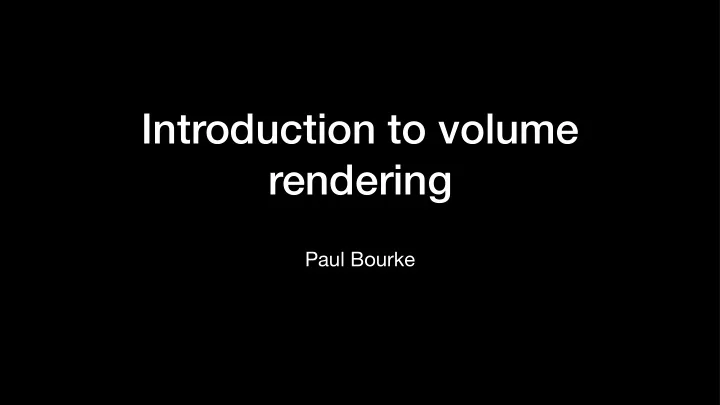

Introduction to volume rendering Paul Bourke
2D drafting/drawing 2D image Points + lines + curves + primitives (circle, rectangle …) Pixels Describes boundaries Describes the interior of a rectangle, a texture 2D drawings are constructed by various geometric primitives, but isn’t suited to representing an image (except ine ffi ciently as a very large number of coloured squares)
3D modelling Volumeric, 3D image Points + lines + faces + texture + primitives (sphere, box …) Voxels Describes surfaces Describes interiors Empty on the inside Full on the inside 3D models are constructed by various geometric primitives, but not suited to representing a volume (except ine ffi ciently as a very large number of coloured cubes)
In a volumetric dataset there is some quantity A digital image contains some quantity sampled on a regular 3D grid. Each cell is sampled on a regular grid on a 2D plane. called a VOXEL (VOlumetric piXEL) In each case the value in the pixel or voxel is mapped onto colour and opacity.
Wide range of applications • Very common form of data in the sciences. • Traditionally one thinks about medical data, for example MRI. Other scanning and 3D imaging technologies include CT (MicroCT) and CAT scans. • Volumetric data also arises from many numerical simulations. Quite common in physics (simulations) and engineering (finite element calculations). • In scanned volumetric datasets the quantity per voxel depends on the scanning technology. For example: MRI essentially gives water content, CT gives density. • For volumetric datasets derived from simulation there can be multiple variables per voxel.
Medical research (MRI) Geology (CT) Rabbits liver, medical research Entomology
Egyptology Astrophysics
Fluid flow in porous material, geology Standing waves, nano-science
Volumetric visualisation is the process of exploring and revealing the structure/interior of a volumetric dataset. The general approach involves a mapping between voxel values and colour/opacity. Same data but di ff erent mappings
3D scanners typically create multiple 2D sections (bottom left). Voxels are not always cubes, often the within slice resolution is higher than between slice resolution. Slice data from the CT scanner Volume visualisation
The details of the user interfaces vary but key is how to specify the mapping from voxel value to colour and opacity.
Data formats • Medical scanners (and others) generally create DICOM files. These are one file per slice but also contains metadata, for example, scanner make/ model, date, scanner settings, size of the voxels in world units, subject identifiers, operator name, institution … and so on. • Other sources of volumetric data just provide the slices in some more standard image format, for example, jpg, ti ff , png … • There are some single file containers for the whole volume. Typically they have a header giving at least the number of voxels on each axis, the size of the voxels in world units, and the size of the items per voxel (eg; byte, short, int …) • No good standards though, many people fall back to a single raw file and the above documented externally.
Additional notes • Voxels are rarely cubes except for volumetric data from physics or engineering simulations. Scanners typically create a higher density within each slice compared to the density between slices. • Voxels are usually all the same size except for some physics and engineering simulations where it may be desirable to have a higher density of voxels in important regions. • The most common voxel values are single bytes (256 states) or unsigned short integers. But can also be floating point and sometimes can be actual colour values (eg: sliced and photographed objects). • Researchers have always, since the start of volumetric data visualisation, created volumes at a resolution that is hard to visualise interactively … despite the advances in realtime computer graphics on the GPU.
Demonstration Dristhi Means “vision” or “insight” in Sanskrit Developed at the Australian National University by Ajay Limaye
Recommend
More recommend